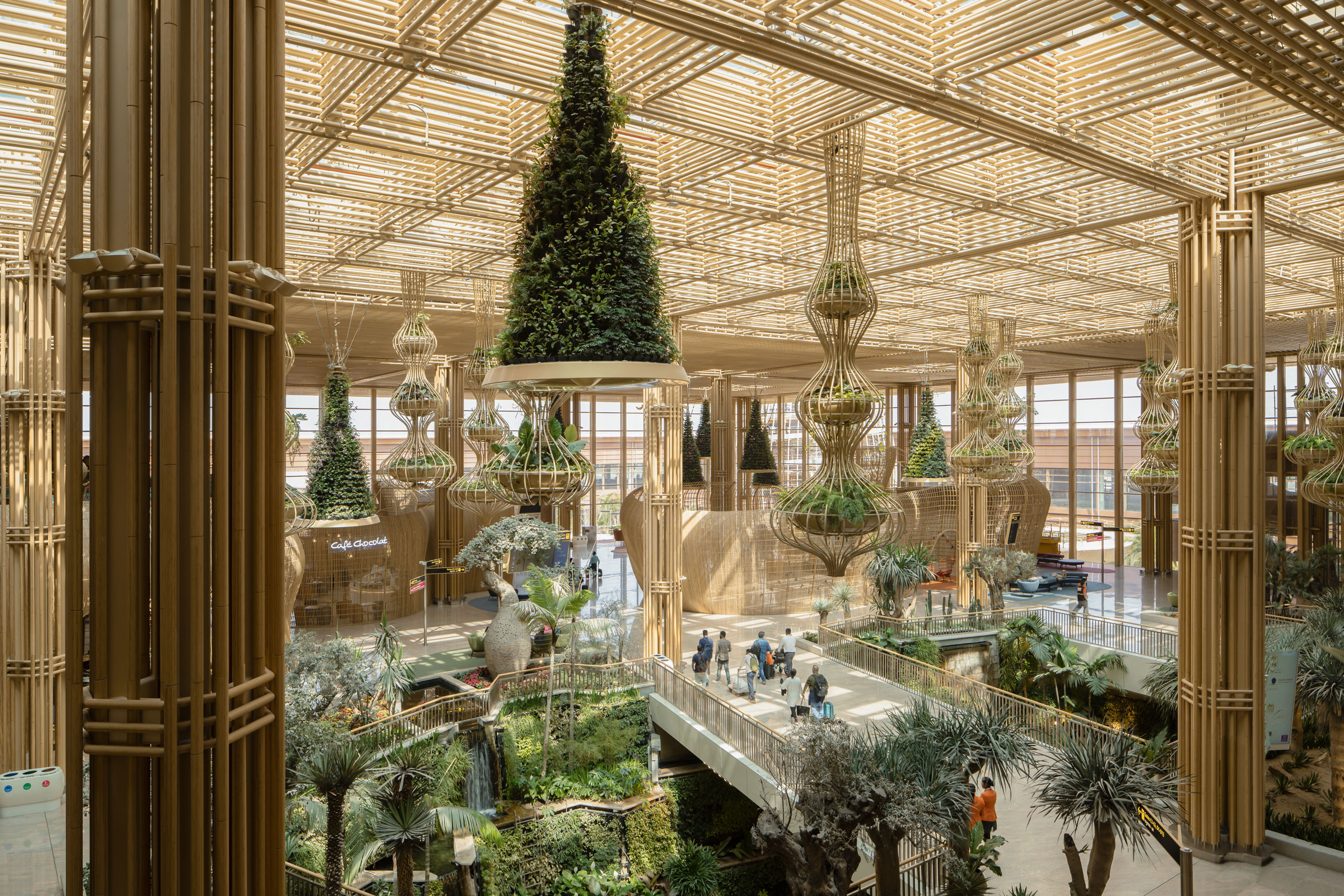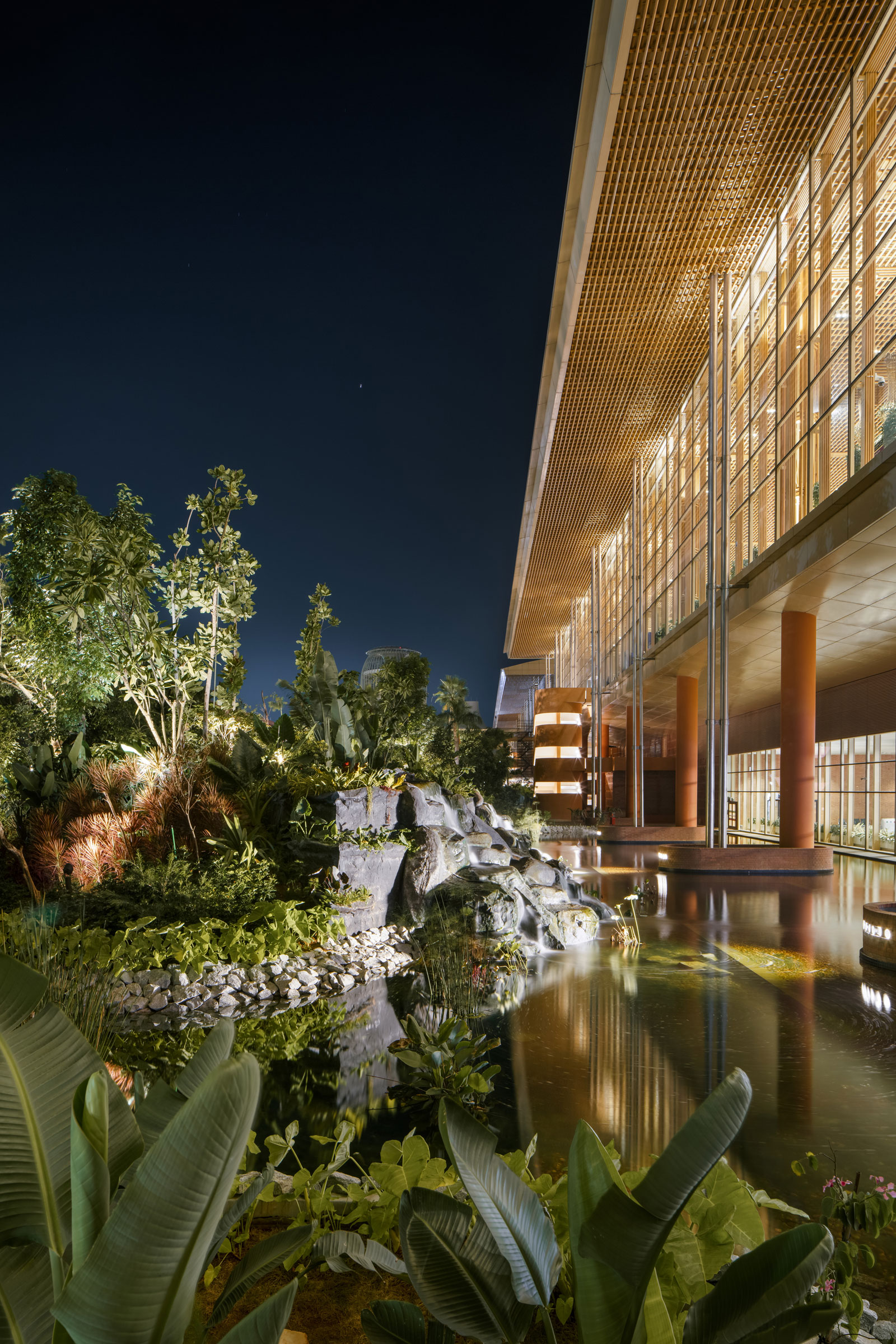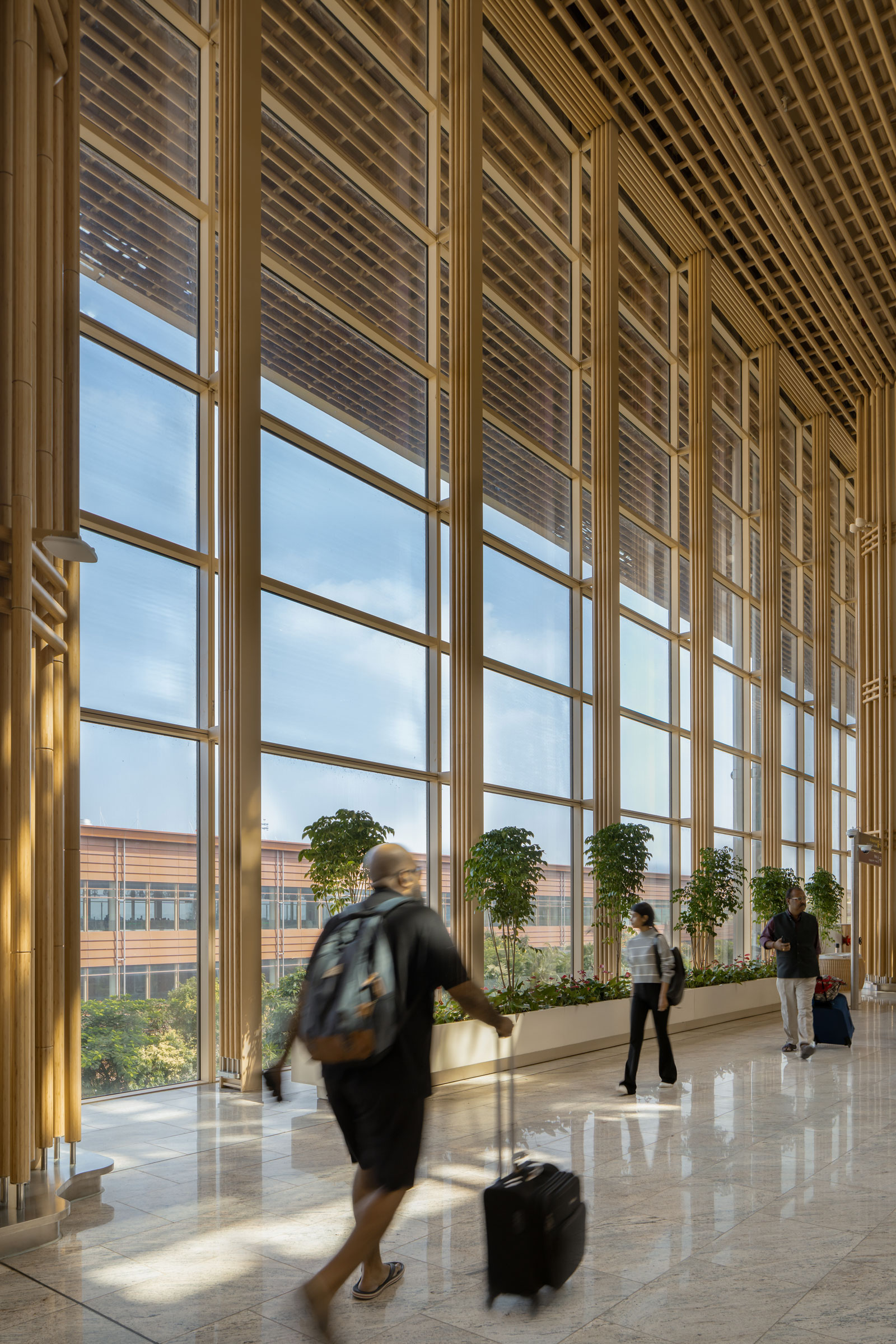Story at a glance:
- SOM wanted the landscaping at this airport project to feel complete today as well as thrive in a future environment.
- The architecture and design team tuned the skylights to provide the perfect amount of filtered natural daylight to the interior spaces.
Airports vary from country to country, even region to region. What airports have in common is their notion of connectivity—they are a significant point of departure or arrival in a traveler’s journey. Our approach to designing terminals around the globe is rooted in a sense of responsibility to deliver designs that truly reflect the identity, culture, and needs of the communities they serve. The challenge is how to design this environment in such a way that is flexible, sustainable, and fosters a memorable experience for passengers. As architects, we at Skidmore, Owings & Merrill (SOM) welcomed this challenge, and together with our collaborative team set off to invert expectations of how an airport should look and feel.
Connecting Travelers to Nature
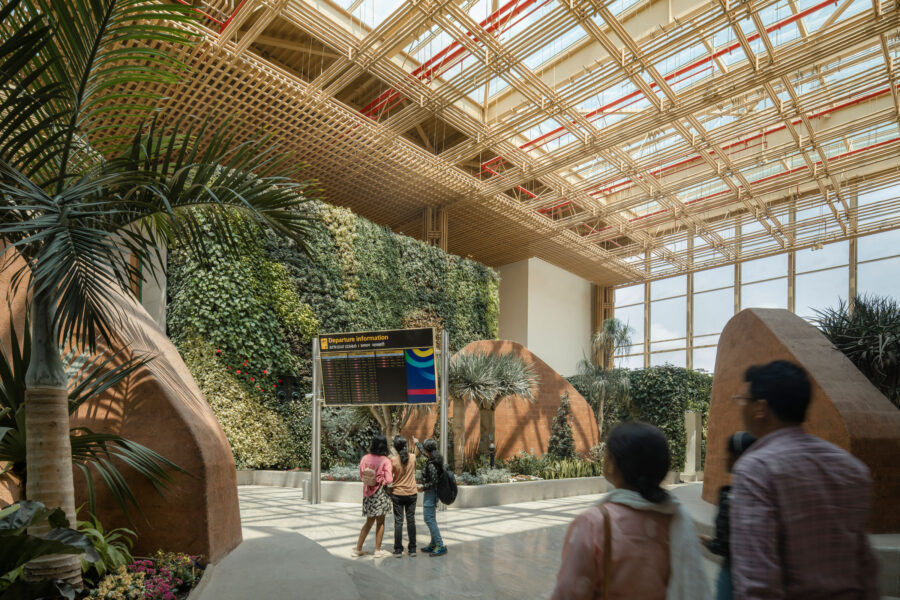
SOM designed the T2 project at Kempegowda International Airport in India to immerse passengers in hanging gardens, surrounded by plants and the soothing sounds of water. Photo by Ekansh Goel, Studio Recall
Designed as a “terminal in a garden,” Terminal 2 (T2) at Kempegowda International Airport in India is inspired by the city of Bengaluru’s “garden city” heritage. We wanted to radically reimagine the travel experience by connecting passengers to nature along each step of their journey. From check-in to boarding, passengers experience a sequence of distinctive spaces, each integrated with a variety of sensory landscape features.
Upon check-in passengers are immersed in hanging gardens, after security passengers can find peace among soothing sounds of water and verdant plants, and before boarding passengers can enjoy a meal beside stepped gardens. If time allows, passengers can traverse a network of bridges and outdoor walkways en route to their gate.
We wanted to create a calming oasis within the hustle and bustle of an international airport. What unfolded was a series of landscaped experiences that create a tranquil environment as well as moments of delight. We proposed an architecture that would be more subtle to complement these landscaping experiences. We explored the use of rich, locally sourced materials that are not typically found in airports. We used natural stone, rattan, brick, and engineered bamboo. This was our first time utilizing engineered bamboo, which proved to be a highly renewable and sustainable material that complemented the garden concept.
We worked closely with our landscape architect, Grant Associates, and our lighting designers, BPI, to balance daylighting requirements of the plants and the energy loads of the building. We wanted our landscaping to feel complete today as well as thrive in a future environment. We tuned the skylights to provide the perfect amount of filtered natural daylight to the interior spaces.
Engineered for Efficiency and Adaptability
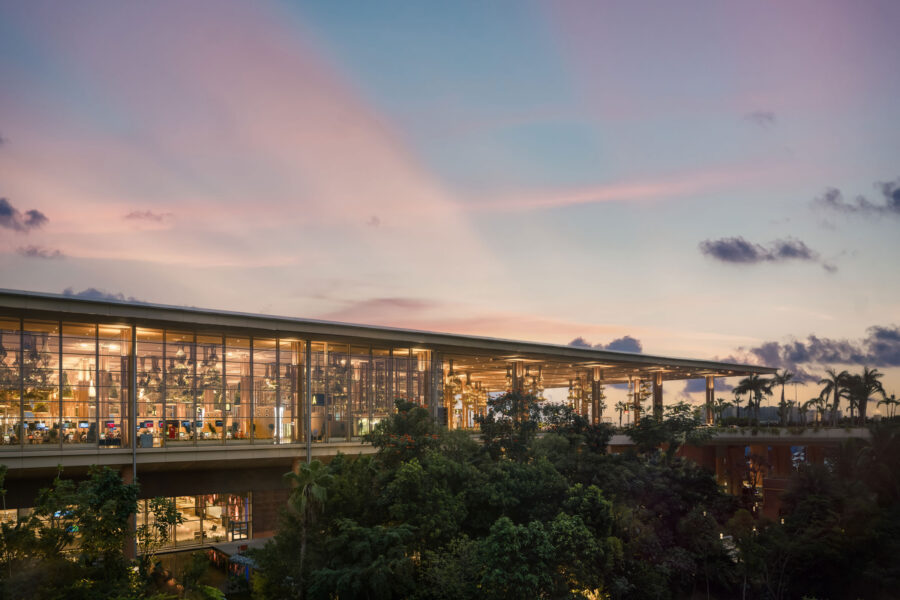
Kempegowda International Airport. Photo by Ekansh Goel, Studio Recall
Airport terminals are also fairly complex buildings that integrate a wide range of movement systems—including aircrafts, passenger boarding bridges, baggage handling systems, airside and landside vehicles, and passengers. They must function as efficiently and smoothly as possible. From the size and characteristics of aircraft to security screening and passenger processing technology, airports are constantly evolving. It takes years to design and build a terminal, and some technologies that exist at the start of the project may be obsolete by the time the terminal opens. Another challenge is designing built-in flexibility to afford terminal operators the ability to adapt to future needs and opportunities that we may not even know about yet.
All the gates at T2 are set up on a two-for-one basis. That is, each can serve either a single wide-body (two-aisle, like the old B747) or two narrow-body aircraft (single-aisle, like the B737). In addition, we designed the piers (concourses) in such a way that the gates can “swing” between domestic and international use. In India and most of the world, departing international and domestic passengers must be segregated from each other. The gate areas of the Bengaluru piers can be opened or closed to one or the other sector of operation, depending on the need or time of day. By getting double use out of all gates we avoided overdesigning the terminal.
We also carefully considered how the airport connects to other modes of transportation today, and in the future. We designed a multi-modal transit hub that connects passengers to buses, cars, and eventually a metro, in a safe and efficient way. The T-shaped, two-level space is situated at the center of the airport and makes the airport entirely walkable.
Ambitious Sustainability Goals
- Outside Kempegowda International Airport in India. Photo by Ekansh Goel, Studio Recall
- Plentiful light brings life to Kempegowda International Airport. Photo by Ekansh Goel, Studio Recall
As large buildings airports are culprits in intensive energy and resource use. As architects it’s our responsibility to design an economical building that still delivers on experience. We implemented a series of sophisticated sustainability strategies to allow the terminal to run entirely on renewable energy. These strategies include extensive solar sharing and intelligent building systems as well as the use of renewable materials. The abundant vegetation is irrigated with rainwater harvested onsite, and the retail area’s waterfalls cool the inside temperature. For the majority of the operating daytime hours the terminal relies on natural daylight, which significantly reduces the energy consumption of the building and fosters a natural interior environment for passengers.
We also focused our engineering on reduced embodied carbon and designing a structure that maximizes the use of locally sourced materials. We designed a small structural grid (only 18 meters by 18 meters) that supports the program spaces needed for 25 million annual passengers. Our smaller grid reduces the material needed and creates a lightness in the structure. The terminal’s roof is made entirely out of domestically produced materials and built with local construction technology
Establishing a Sense of Place
Our goal for T2 was also to balance the requirements of bustling international travel with a need to create a building with a human scale and an uplifting experience. We often engage artists and designers to develop a deeper and more meaningful understanding of a place. Integral to the design of the new terminal was the idea of creating a passenger experience that captured the spirit of Bengaluru and the culture of Karnataka. We collaborated with celebrated fashion designers Abu Jani and Sandeep Khosla (AJSK) to study the local landscape, traditional dance, art, and architecture. These insights inspired the materials, forms, and installations in the new terminal. We are excited for passengers to experience our design for many years to come.
Derek A.R. Moore, design principal at Skidmore, Owings & Merrill, also contributed to the story.

